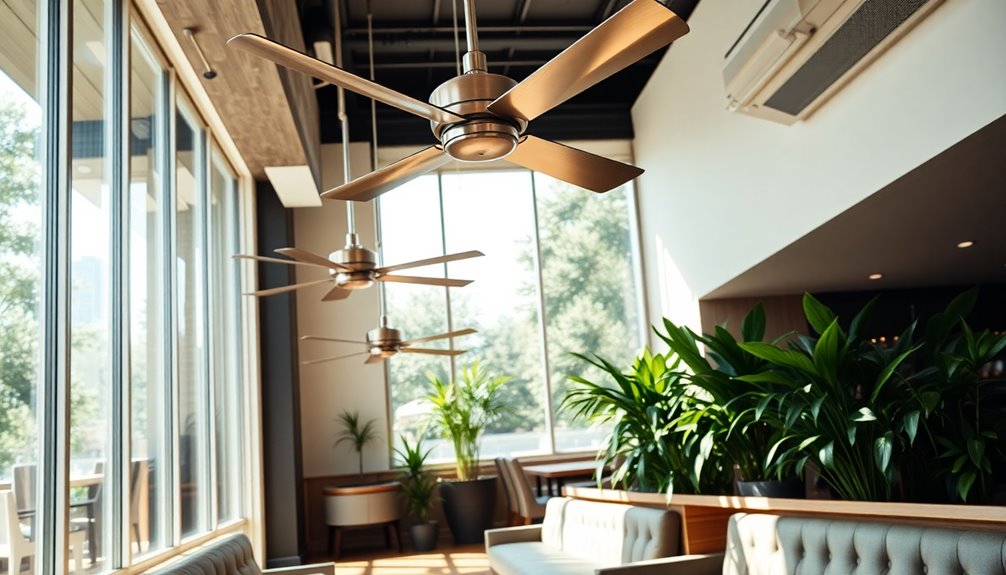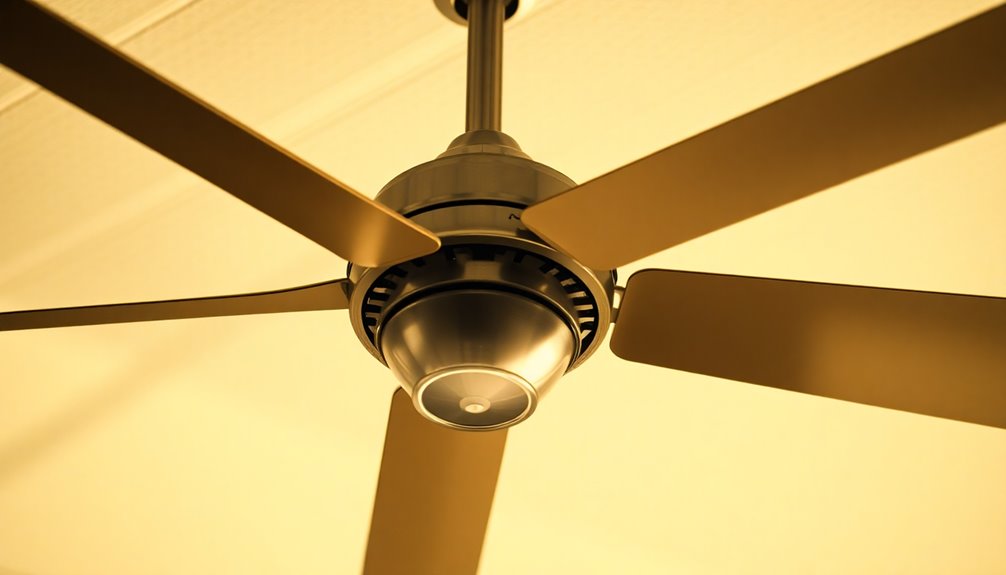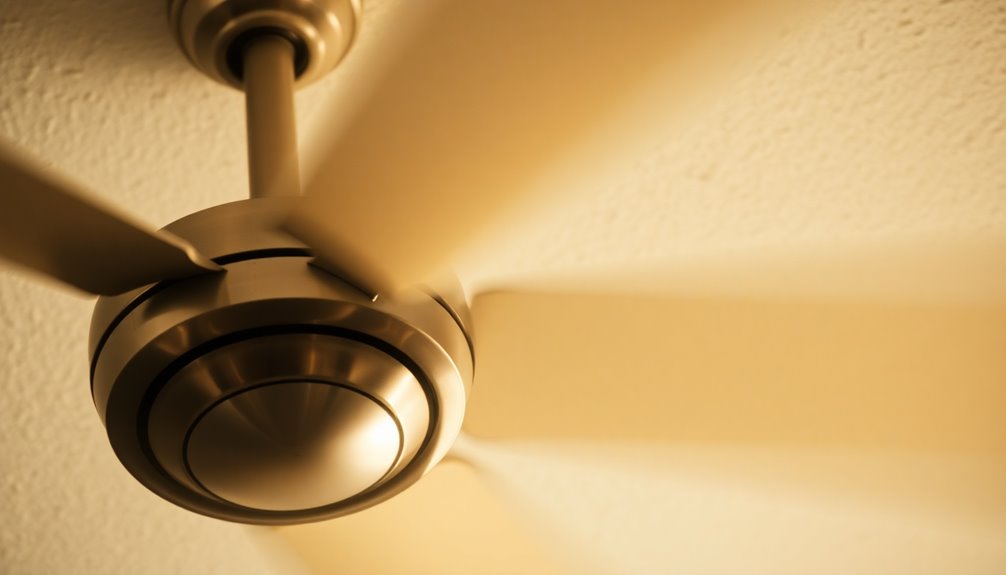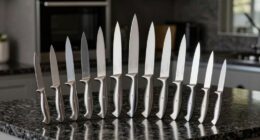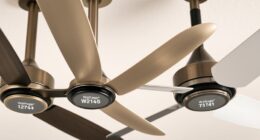In the summertime, you want your ceiling fan to spin counterclockwise. This rotation creates a downdraft that pushes cool air down, giving you a revitalizing breeze. You'll feel cooler without having to lower the thermostat, potentially saving up to 30% on your energy bills. It improves airflow and helps your air conditioner work more efficiently, keeping your space comfortable. If you're unsure how to adjust the fan direction or want tips for specific room types, there's more helpful info available that can enhance your summertime comfort experience even further. For rooms with lower ceilings, opting for low profile ceiling fans without lights can be an excellent choice to maintain proper head clearance while still enjoying the cooling benefits. These fans are sleek and functional, blending seamlessly into your space without unnecessary bulk. Ensuring the fan is spinning in the correct direction during the summer enhances its efficiency, making these models just as effective in creating a refreshing atmosphere.
Key Takeaways
- Ceiling fans should rotate counterclockwise in summer for optimal cooling.
- Counterclockwise rotation creates a downdraft effect, pushing cool air downwards.
- This direction can make a room feel up to 4 degrees cooler without adjusting the thermostat.
- Proper fan direction can lead to energy savings of up to 30% on air conditioning bills.
- Always check fan direction before summer; adjust using the ceiling fan switch, pull chain, or remote control.
Ceiling Fan Direction Basics

Understanding ceiling fan direction is essential for maximizing comfort in the summer months. To keep your space feeling cool, you'll want to set your ceiling fan to rotate counterclockwise. This direction creates a downdraft effect, pushing cool air downward to enhance your comfort.
When the fan blades spin in this way, you experience a wind chill effect that makes you feel cooler, even if the room temperature remains the same.
Running your ceiling fan at high speed during the summer can allow you to raise your thermostat setting by about 4 degrees while still feeling comfortable. This simple adjustment can lead to significant energy savings, cutting down your reliance on air conditioning systems by up to 30%.
To check the fan direction, stand directly beneath the fan and observe the airflow; if the air is blowing down towards you, it's set correctly for summer use.
Benefits of Counterclockwise Rotation

Setting your ceiling fan to rotate counterclockwise offers several benefits that can considerably enhance your summer comfort. This direction creates a downdraft, pushing cool air downward, which can make a noticeable difference in how you feel.
Here are three key benefits of counterclockwise rotation:
- Cooling Effect: With the wind chill effect, you can feel up to 4 degrees cooler without adjusting your air conditioning. This is a simple way to boost comfort while staying cool.
- Energy Savings: Running your ceiling fan in this direction can reduce your reliance on air conditioning, leading to energy savings of up to 30%. This not only lowers your bills but also promotes a more efficient use of energy.
- Improved Airflow: Counterclockwise rotation guarantees maximum airflow, maintaining a consistent room temperature. This efficiency enhances the performance of your air conditioning system, allowing it to work less hard while keeping your space comfortable.
Optimal Settings for Summer

To maximize comfort during the summer months, it's crucial to adjust your ceiling fan settings properly. Set your ceiling fan direction to counterclockwise to create a downdraft that pushes cooler air downward. This motion enhances air circulation, making your space feel more comfortable even if you raise the thermostat by about 4 degrees.
Running your fan at high speed in counterclockwise mode not only improves the wind chill effect but can also greatly reduce energy costs—up to 30%—by decreasing your reliance on air conditioning. This is especially beneficial during the hot summer days when you want to stay cool without breaking the bank.
To verify your fan's direction is correct, stand beneath it and feel for airflow. You should notice the air being pushed straight down, creating that invigorating breeze you desire.
For outdoor fans, the same counterclockwise setting at high speed can enhance airflow and comfort, particularly in still conditions. With these ideal settings, you'll enjoy a cooler environment while saving money on energy bills this summer.
Room-Specific Fan Directions

Adjusting your ceiling fan direction for specific rooms can enhance comfort even further. In the summer, keeping your fan rotating counterclockwise optimizes airflow and creates a rejuvenating cooling effect.
Here are some room-specific tips to contemplate:
- High Ceilings: For rooms with high ceilings, make sure your fan spins counterclockwise to push the cooler air downwards. This prevents warm air from gathering near the ceiling and enhances overall energy efficiency.
- Smaller Rooms: In smaller spaces with lower ceilings, maintain the counterclockwise rotation but make speed adjustments. You'll want to avoid overwhelming airflow that could disrupt your comfort.
- Outdoor Spaces: Don't forget about outdoor ceiling fans. Set them to counterclockwise as well to maximize airflow, especially in still conditions, which further enhances your summer experience.
Changing Fan Direction Tips

Changing your ceiling fan's direction for summer is crucial for maximizing comfort in your home. To enjoy a revitalizing cooling effect, set your fan to rotate counterclockwise, which creates a downdraft that pushes cool air down. Here are some tips to change the fan direction effectively:
| Method | Instructions | Notes |
|---|---|---|
| Ceiling Fan Switch | Verify the fan is off, then locate the switch on the fan body. | Switch it to counterclockwise. |
| Pull Chain | Turn off the fan, then pull the chain to toggle direction. | Pull until you feel the breeze. |
| Remote Control | Power off the fan, press and hold the fan button until the light blinks. | Check to verify it's counterclockwise. |
| Seasonal Reminder | Change the direction at the start of summer, ideally during Daylight Savings Time. | Boosts energy efficiency! |
Frequently Asked Questions
How Can I Tell if My Ceiling Fan Is Going Clockwise or Counterclockwise?
You might think it's tricky to tell if your ceiling fan's going clockwise or counterclockwise, but it's actually pretty simple.
Stand directly beneath it and feel the airflow. If you feel a cool breeze pushing down, it's spinning counterclockwise. If there's hardly any airflow and it feels warm, it's rotating clockwise.
Don't forget to check for a switch or remote control to change the direction if needed!
What Is the Best Direction for Ceiling Fans in Summer?
To get the most comfort in summer, you'll want your ceiling fan to spin counterclockwise.
This direction creates a downdraft, pushing cool air down and providing that revitalizing breeze you crave. You'll feel cooler without lowering the thermostat, saving on energy costs.
Make certain to regularly check the fan's direction to verify it's working efficiently.
With the right settings, you can enjoy a comfortable room while cutting back on air conditioning use.
How Do I Know if My Ceiling Fan Is Summer or Winter?
To know if your ceiling fan is set for summer or winter, stand beneath it and feel for airflow. If you feel a strong breeze blowing downward, it's in summer mode.
You can also check the fan's reversing switch; flipping it changes the direction of the blades.
Look for a sticker on the motor housing that indicates the proper settings for both seasons.
Adjust accordingly for maximum comfort throughout the year!
How Do You Tell the Direction of a Fan by the Blades?
Figuring out a fan's direction is like deciphering a dance; the blades tell the story.
Stand beneath the fan and watch the rotation. If the blades spin counterclockwise, they're pushing air down, creating a cooling breeze. If they move clockwise, they're lifting air, perfect for warmth.
You can also feel the airflow: a strong breeze means counterclockwise, while a gentle touch indicates clockwise.
Adjust the settings as needed for comfort.
Conclusion
In the blazing heat of summer, setting your ceiling fan to rotate counterclockwise can feel like having a cool breeze from the Arctic right in your living room. You'll experience a revitalizing airflow that helps lower the temperature and keeps you comfortable. Remember to adjust your fan settings for different rooms to maximize that chill vibe. With just a simple flick of a switch, you'll transform your space into a summer oasis, making the heat a distant memory!

